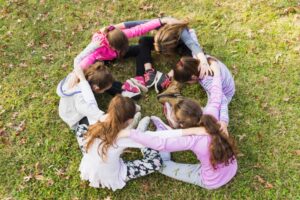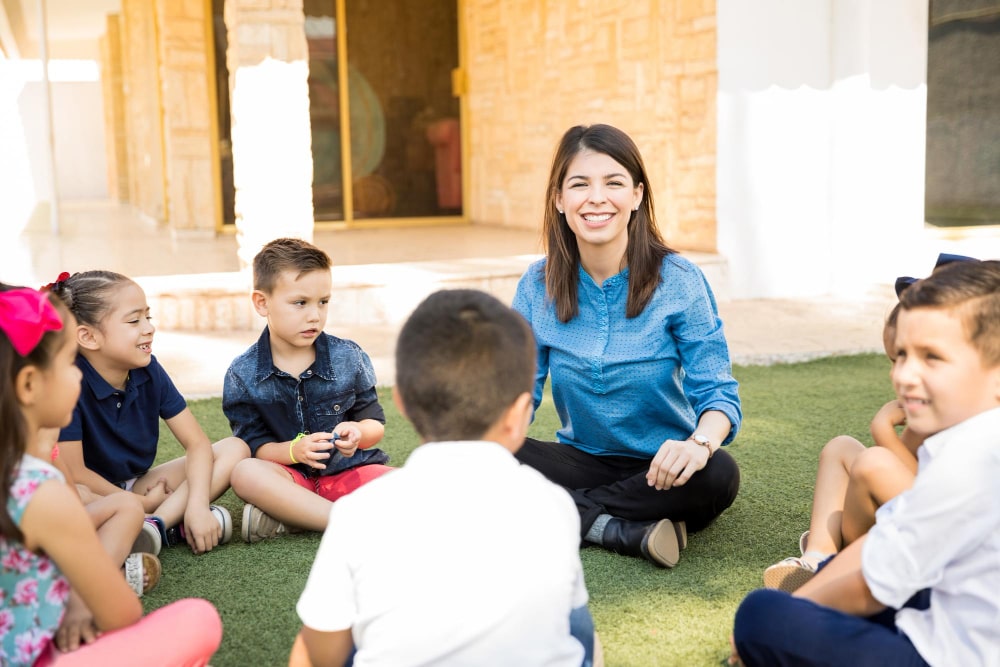15 Fun & Engaging SEL Activities for Preschool & Kindergarten
Social and emotional learning (SEL) is an essential part of a child’s development, particularly in the early years. Teaching young children the skills to recognize, understand, and manage their emotions helps them to become healthy and successful individuals.
Social Emotional Learning (SEL): Everything You Need to Know
To help parents and educators teach these important life lessons, we have compiled a list of 15 fun and engaging activities for preschoolers and kindergarteners. From games to stories and art activities, these activities are sure to get your little ones excited about learning social and emotional skills.
Read on to learn more about these activities and how to incorporate them into your lesson plans.
#1 Building Emotional Awareness with a Feelings Check-In

Teaching preschoolers and kindergarteners about their emotions can be challenging. A great way to build emotional awareness is through a “Feelings Check-In”. This activity gives children an opportunity to recognize their own emotions and the emotions of others.
To start the activity, provide your students with a chart of different feelings (e.g., happy, angry, embarrassed, frustrated). Then have the students discuss what each feeling looks like, sounds like, and feels like.
Once they understand the different emotions, have them stand in a circle and take turns expressing how they are feeling. For example, they could say, “I am feeling happy today” or “I am feeling frustrated”. Other students should then repeat the feeling that was expressed. This will help them to learn to recognize each emotion in themselves and others.
Finally, you can use this activity as a way to talk about positive coping strategies for managing their emotions. If a student says they are feeling frustrated, ask them what strategies they can use to help them manage their frustration.
#2 Draw Pictures About Feelings
Encouraging preschoolers and kindergarteners to draw pictures about their feelings can be a fun and creative way to help them develop emotional literacy. Before they start, ask them questions like: “What colors represent that emotion? What would you draw to show how you’re feeling?” After they finish, discuss the drawing with them and explore any emotions or stories behind it.
This activity allows children to explore how emotions and colors can be connected and how their own feelings can be portrayed through artwork. Furthermore, it encourages kids to identify their feelings and think of creative ways to express them. If a child is having difficulty expressing emotion, ask them to choose a color that represents that feeling and then draw something that conveys that feeling.
For example, if they are feeling angry, they might draw an angry face with a dark red color. Or, if they are feeling happy, they could draw a rainbow with yellow and orange colors. Allowing them to draw pictures of their feelings will help them develop better emotional awareness and understanding of how different emotions can be expressed in different ways.
#3 Music and Movement
Music and movement are two activities that are a great way to engage preschoolers and kindergartners in social and emotional learning (SEL). Music can help children to express their feelings while also providing an outlet for releasing energy. Movement can help children to understand how their body works, as well as help them to understand the differences between strong and weak emotions.
Some examples include having children move in slow motion to explore their emotions, encouraging them to act out stories with music, or having them do an obstacle course with directions in the form of music. Other ideas include having children use rhythm instruments to express different emotions or lead a group of children in a freeze dance.
Music and movement activities can provide a fun and creative way for children to learn about emotions, develop their listening skills, practice focusing, and learn how to cooperate with others.
#4 The Caring Circle Activity

The Caring Circle Activity is a great way to help young children build relationships with peers, and practice self-regulation. This activity involves each child sitting in a circle with their peers and taking turns sharing their feelings.
First, begin by introducing the concept of the Caring Circle by explaining that it is a time when each person can share what they are feeling. Let them know that it is important to be respectful of each other’s feelings and to listen without judgment or criticism.
Then, have each child take turns saying what they are feeling. Ask open-ended questions to spark conversation and provide guidance if needed. Once everyone has had a chance to share, discuss what emotions were shared and how everyone was feeling. This activity can help foster positive relationships between classmates, as well as increase self-awareness and emotional regulation.
#5 Sort Feelings into Categories
Sorting feelings into categories can be a great way to help preschoolers & kindergarteners develop their emotional literacy skills and gain insight into their own feelings.
To start, give each child a set of emotion cards. The cards should contain different facial expressions that represent a variety of emotions. Ask the children to look at each emotion card and decide which feeling it represents. Once they have determined which emotion is being expressed, have them sort the cards into separate piles based on the different feelings.
After the cards are sorted, discuss the differences between the various emotions. Explain how each emotion can be expressed in different ways and what situations might cause someone to feel that particular emotion. Encourage children to think about how they might be feeling in certain situations and why they might be feeling that way.
Once they have a good understanding of the emotions and their varying expressions, have the children sort the cards into one pile again. Then have them take turns pulling a card from the pile and describing how they might feel if they were experiencing that particular emotion.
#6 Conversation Starters
Conversation starters are a great way to engage your students in discussions about social-emotional learning. These activities can help children explore emotions, practice communication skills, and build self-confidence.
One fun way to start conversations is to ask questions that require more than just yes or no answers. For example, you can ask: “What was the best part of your day?” Or, “What makes you really happy?”
You can also use stories as conversation starters. Ask your students to share stories about something that happened to them recently, or talk about an event they’re looking forward to.
Also, you can ask your students open-ended questions to get conversations started. Open-ended questions give your students the opportunity to express their thoughts and feelings in more detail. Examples of open-ended questions include: “How did you feel when that happened?” or “What do you think about this situation?”
#7 The Calm Down Jar
The Calm Down Jar is a great way to help kids learn self-regulation and mindfulness techniques in an engaging and fun way! The activity begins by asking the children to make a jar together out of a recycled container, or something similar.
Once the jar is complete, add in several items such as colorful gems or stones, glitter, sequins, or small toys. Ask the children to put a few drops of essential oils in the jar, and then stir it up with a stick or spoon.
Next, explain to the children that when they need to take a moment to calm down, they can open the jar and take out one of the items. Invite them to pay attention to the colors and textures they are experiencing while they focus on their breathing.
Finally, ask them to replace the item back in the jar when they are feeling more relaxed. Encourage them to use the jar whenever they need it, and also to share it with their friends if they would like.
#8 Use Puppets to Show Feelings

Puppets allow children to act out different emotions in a safe space, where they can be creative and express themselves without judgment. To get started, introduce the puppets and let the children take turns picking out their favorite. Explain that the puppets can be used to show different emotions. Ask the children to pick a puppet and then discuss what feeling the puppet is expressing. Talk about how the puppet might be feeling, what it is thinking, and how it can show its emotions. Encourage the children to use their imagination and come up with scenarios for their puppets.
Once the children understand how to use the puppets, they can play fun games to further explore feelings. Another fun game is to have the children take turns making up stories for their puppets. This encourages creative thinking and helps children learn how to recognize and express their own emotions.
#9 The I Statements Game
The I Statements Game encourages them to be mindful of how they are feeling and articulate their feelings without lashing out at others.
To play the game, gather together in a circle. Ask the children to think about how they feel and make up an “I statement” such as “I feel angry when…” or “I feel scared when…”. Then, have them say the sentence out loud and share with the group what makes them feel that way.
Next, it’s time for the rest of the group to respond to the I statement with an appropriate comment or suggestion. This could be something like “That sounds really scary” or “Maybe you could try talking about it with someone you trust.”
This game encourages problem-solving skills since they must come up with suggestions on how to handle their feelings. Plus, it’s a great way to foster communication within the group.
#10 The Buddy System
The Buddy System is a great way to teach preschoolers and kindergartners about cooperation and friendship. By pairing each student with a buddy, they can learn to rely on and support each other while also building trust. This activity can be done in the classroom or at home and is simple to set up.
First, assign each student a “buddy”. Then, encourage them to work together on projects and activities. This could involve playing a game together, doing a puzzle, or helping each other with schoolwork. If your students are working on individual projects, have them take turns helping each other out or brainstorming ideas together.
The Buddy System helps them to be kind and respectful of one another and encourages them to lend a helping hand.
#11 The Kindness Tree Activity
The Kindness Tree Activity is a great way to help children learn about kindness and respect for others. It’s a fun and engaging activity that can be done in the classroom, at home, or in any setting where you have a few minutes to spare.
To get started, ask your students to draw a tree trunk on their piece of paper. Then, tell them to cut out leaf shapes from the other pieces of paper and glue them onto the tree trunk. Ask each student to write an act of kindness they can do on each of the leaves. After they’ve finished writing their kind acts, have them hang their trees up in the classroom or at home as reminders of how they can show kindness and respect for others.
This activity is a great opportunity to talk about why being kind is important and how we can practice kindness every day.
#12 Exploring Emotions with Play-Doh

Play-doh is a classic activity that can be used to help children of all ages understand their emotions. Through this hands-on, tactile activity, young students can learn to express and recognize their feelings.
To begin, give each student a small ball of Play-Doh. Ask them to pick one emotion that they’re feeling and have them mold the Play-Doh into a shape or a character that represents that emotion. After they’ve created their Play-Doh character, have them explain why it represents the emotion they chose.
Once each student has shared their Play-Doh character, ask them to look around the room and guess which emotion each other student has chosen. Encourage them to make connections between the shapes and characters created and the emotions they represent.
This activity helps them develop empathy and understanding by creating a safe and open environment where students can express themselves without judgment.
#13 The Gratitude Rock Activity
The Gratitude Rock Activity is a fun way to help young children learn the power of gratitude. This activity starts with each child collecting a rock from outside or a special rock they’ve collected before. Have the children decorate their rock with paint, markers, stickers, or other materials. Then, have them write something they’re grateful for on their rock. Encourage the children to share their rocks with each other and explain what they’re thankful for.
Once everyone has finished sharing, take the rocks and put them in a special spot in the classroom. Every time the children look at their rocks, they’ll be reminded of all the things they have to be thankful for. This activity encourages children to think about and express what they’re grateful for and also helps them to recognize and appreciate the positive things in their lives.
#14 The Worry Monster Game
The Worry Monster Game helps children to learn about their worries, fears, and anxieties in a fun and engaging way.
To play the game, have the children sit in a circle. Then, introduce the Worry Monster. Explain that the monster loves to eat worries and anxieties. Ask the children to think of something they’re worried or anxious about, and then share it with the group.
Once all the worries have been shared, have the children pass the worry monster around the circle. As they do, they can explain their worry to the worry monster. When everyone is finished talking, the worry monster will be full of worries and anxieties!
This activity is a fun and interactive way for kids to learn about emotional regulation, empathy, and communication.
#15 The Empathy Ball Activity
The Empathy Ball Activity helps children better understand and appreciate the emotions of others. To do this activity, you will need a beach ball or any other large ball that can be divided into four quadrants.
On each of the four quadrants, draw an emotion such as happiness, anger, sadness, and fear. Once the emotions are drawn on the ball, have the students stand in a circle and take turns throwing the ball. When a student throws the ball, they should name the emotion shown on the part of the ball that landed in front of them. Then, have the student explain how they think someone might feel in a situation where they would experience that emotion.
This activity is also a great opportunity for kids to learn about different emotions and how to respond to them in a respectful manner.
Conclusion
It is essential to provide children with opportunities to practice social and emotional skills and learn how to manage their emotions. Through the creative use of these activities, preschoolers and kindergartners can learn and practice skills such as emotional awareness, cooperation, communication, kindness, gratitude, empathy, and more. With guidance from adults, children can explore their feelings and build positive relationships with their peers. Try out some of these activities today and watch your child’s self-awareness and relationships with others grow!
These 6 Essential Life Skills are Secret to Raising Successful Kids





